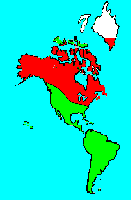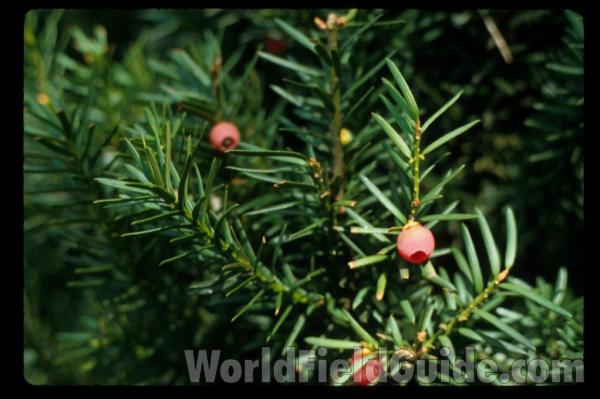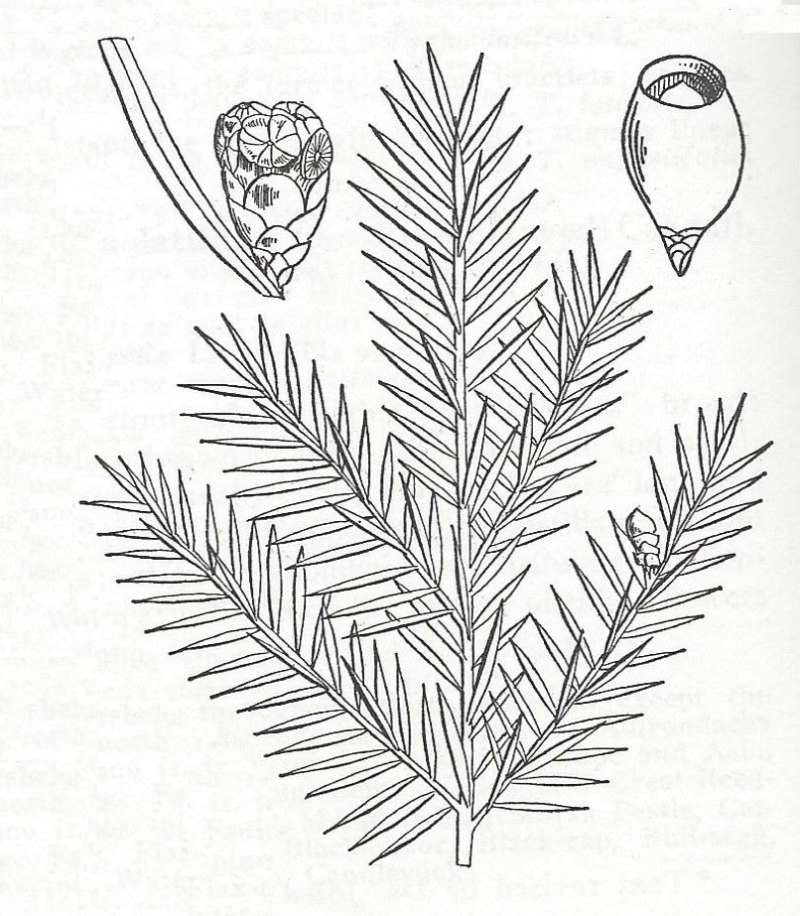SPECIES INFO
American Yew (Taxus canadensis) is found from eastern Canada west to Manitoba and south to Virginia and Iowa. The soft, red, berry-like fruits are distinctive. Needles are stalked and less than one inch long. This is a low evergreen shrub.Taxus genus (yews) is found in Europe and northern Africa, the Orient, central Eurasia, and North America. There are about ten species in this genus. These are a group of evergreen trees or shrubs with spirally arranged linear, flat leaves (needles.) This genus is represented in North America by five species.
Yews (Family Taxaceae) is a small family of plants with sporadic distribution. There are only twenty species in the family placed in six different genera. This is a tentative list of the United States species:
Taxus bacata - - European Yew - Introduced
Taxus brevifolioa - Pacific Yew - Coastal Pacific NW
Taxus canadensis - American Yew - East USA
Taxus cuspidata - Japanese Yew - Introduced
Taxus floridana - Florida Yew - Florida Panhandle
Torreya california - California Torreya - Central California
Torreya taxifolia - Florida Torreya - Florida Panhandle
Conifers (Order Coniferae) is an important group of trees and bushes found throughout the world. Although very common in the forests everywhere, this group of plants has only about 520 species. They are characterized by having needles or scales. Pines, spruces, yews, redwoods, and junipers are typical examples of conifers.
Most of these plants have cones, but some members have berry like fruits.
Gymnosperms are a group of trees and bushes usually characterized by needles (some have scales) and the production of cones to support the seeds. Most species are evergreen. (The actual technical definition has to do with the method of producing the seed.)
There are over 600 species of Gymnosperms known to science. The largest genus in this group in terms of species is the Pine genus with about 120 species. The second most common genus is the Podocarpus genus which is normally a more tropical group than the Pines.
Kartesz lists 135 species as growing in greater North America, including Hawaii, Puerto Rico, and the Virgin Islands.
Seed plants (Phylum Embryophyta) are generally grouped into one large phylum containing three major classes: the Gymnosperms, the Monocots, and the Dicots. (Some scientists separate the Gymnosperms into a separate phylum and refer to the remaining plants as flowering plants or Angiospermae.)
For North American counts of the number of species in each genus and family, the primary reference has been John T. Kartesz, author of A Synonymized Checklist of the Vascular Flora of the United States, Canada, and Greenland (1994). The geographical scope of his lists include, as part of greater North America, Hawaii, Alaska, Greenland, Puerto Rico, and the Virgin Islands.
Kartesz lists 21,757 species of vascular plants comprising the ferns, gymnosperms and flowering plants as being found in greater North America (including Alaska, Hawaii, Greenland, Puerto Rico and the Virgin Islands.
There are estimates within the scientific world that about half of the listed North American seed plants were originally native with the balance being comprised of Eurasian and tropical plants that have become established.
Plant kingdom contains a large variety of different organisms including mosses, ferns, and seed plants. Most plants manufacture their energy from sunlight and water. Identification of many species is difficult in that most individual plants have characteristics that have variables based on soil moisture, soil chemistry, and sunlight.
Because of the difficulty in learning and identifying different plant groups, specialists have emerged that study only a limited group of plants. These specialists revise the taxonomy and give us detailed descriptions and ranges of the various species. Their results are published in technical journals and written with highly specialized words that apply to a specific group.
On the other hand, there are the nature publishers. These people and companies undertake the challenging task of trying to provide easy to use pictures and descriptions to identify those species.



